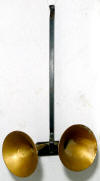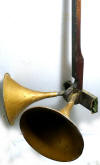Springers museum......

The phono collection ......
of Stroviols and other horned stringed instruments
|
Springers museum...... |
 |
||
|
The phono collection ...... |
|||
|
of Stroviols and other horned stringed instruments |
|
|||||||||||||||||||||||||
|
Phono instruments by Howson |
|||||||||||||||||||||||||
|
|
|||||||||||||||||||||||||
 |
Twin horn one string phono fiddle early 20th century |
 |
There are many one string phono fiddles still in evidence, these were often used as novelty items and often in musical hall and other stage acts. These usually work on a flat circular cellophane diaphram, a crude metal bridge glued directly to the surface. They were held and played in the cello position and tuned variously to suit the player. Strohviols and Howson were the most prominent makers. They were popular up until the 1940s and most retired to the loft. |
Mina Forsyth, c.1923ish with a one string phono fiddle Photo courtesy Alan Davidson | |||||||||||||||||||||
|
|
|||||||||||||||||||||||||
|
Hardanger Fiddles Pochette and kit violins Metal violins Decorated violins Unusual violas Fakes Mute violins Early violins |
|||||||||||||||||||||||||
|
|
|||||||||||||||||||||||||
copyright © pamelawilson since 2004. All rights reserved. No colour photograph may be copied or reproduced without permission.